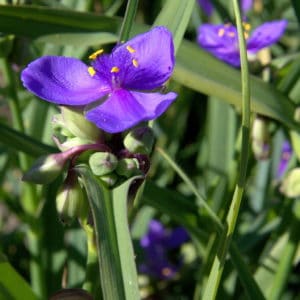Hello Fellow Readers,
I received an inquiry about an invasion amongst a patch of pachysandra from Josephine (Jo) of Phillipsburg, NJ. “How do I best get rid of spider warts?” she asked. We shared a back-and-forth email chat that played out like an investigation.

Tradescantia ohiensis – Attribution:
C T Johansson [CC BY 3.0 (https://creativecommons.org/licenses/by/3.0)]
“The solution is to weed them out manually, I would say; though I don’t have direct experience.”
Jo confirmed its indeed Spiderwort causing her dilemma. “They are also white and pink,” she said. “I do keep digging them out, but they come back. Weeds and grass also grow in the pachysandra beds. Will cutting back the pachysandra make it thicker, thereby eliminating weeds? Is there a safe product out there to use?”
Using a weed killer would kill the pachysandra as well. Typically, established pachysandra wins over others, meaning it chokes out other plants. If sparse, I’ve read you can shear them back in spring using a weed whacker set at an elevated level. Or, clip them by hand which makes cleaner cuts – better for the plants, though tedious to do. Keep the foliage half the height so it can rejuvenate.
“Is your pachysandra healthy?” I asked. There’s a fungus impacting pachysandra called Volutella blight. If infected, leaves turn yellowish with brown patches that can ultimately spread to the entire leaf. Stems can be infected too turning blackish-brown and eventually killing the plant. Mine is making a slow but steady comeback after using a general-purpose organic fertilizer (Pro-Gro 5-3-4 by North Country) in early spring the last few years. Don’t fertilize in the fall as it could cause further stress to the plants.
Penn State Extension suggests removing debris around pachysandra, avoid overhead sprinkling, and treat with a fungicide during wet seasons to protect the plants from getting the blight. Remove infected leaves and plants to keep the disease from spreading to others.
“My pachysandra is being treated for blight and is looking better in that regard,” Jo wrote back.
Mystery solved why her pachysandra thinned out, making room for opportunists. The weed-whack method of thickening is too risky as it may add further stress to the plants, setting back their recovery. Instead, I suggest Jo keep pulling the invaders and fill in the garden with new plugs of pachysandra.
By the way, Spiderwort in the right place is not considered an invader. They’re adored by bees and butterflies making them ideal for meadows.
The name Spiderwort comes from the secretion when stems are cut that solidifies into silk-like strings like a spider’s web. If it’s the name that gives you the heebie-jeebies, they’re also known as Bluejacket. Stylish! Garden Dilemmas? AskMaryStone@gmail.com
How to encourage pachysandra to thrive in full sun: I visited with Kathy of East Stroudsburg PA who pointed out her newly installed pachysandra showing stress. She planted it in full sun, which I thought could be the dilemma. But the browning where the stem meets the roots could be a symptom of too much water. I’ve never planted this shade-loving evergreen groundcover in full sun. However, others say it can work out well if the roots are kept cool. They suggest mulching a new installation with three inches of mulch (I prefer hemlock) or chopped up dry leaves to keep the roots cool. Once established, the plant itself should shade the roots. Of course, during hot, dry spells irrigation will be needed– preferably drip to help prevent fungi.
 Pachysandra terminalis (commonly called Japanese Spurge) is hardy zones 5 to 9 and native to Japan and China. Some consider it invasive.
Pachysandra terminalis (commonly called Japanese Spurge) is hardy zones 5 to 9 and native to Japan and China. Some consider it invasive.


